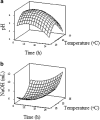Physicochemical and functional properties of yeast fermented brown rice flour
- PMID: 26344967
- PMCID: PMC4554679
- DOI: 10.1007/s13197-014-1661-7
Physicochemical and functional properties of yeast fermented brown rice flour
Abstract
In the current study, effects of fermentation on physicochemical and functional properties of brown rice flour (BRF) were investigated. Fermentation conditions were optimized using response surface methodology to achieve moderate acidity (pH 5-6), specifically pH 5.5 of brown rice batter with time, temperature and yeast concentration as the independent variables. The results indicated that brown rice batter was well fermented to maintain pH 5.5 at optimum conditions of 32 °C for 6.26 h using 1 % yeast concentration. Fermentation at moderate acidity significantly increased the levels of protein, total ash, insoluble fiber, soluble fibre, minerals, phenolics, antioxidants, resistant starch, riboflavin, pyridoxine, nicotinic acid, γ-tocotrienol, and δ-tocotrienol. However, it reduced the contents of γ-oryzanol, γ-tocopherol, α-tocopherol, phytic acid, amylose and total starch. Foaming capacity, foaming stability, oil holding capacity, gelatinization temperatures, enthalpy and whiteness of BRF were increased after fermentation. In contrast, its swelling power, water solubility index, hot paste viscosity, breakdown, and setback significantly decreased. Microstructure of BRF was also influenced, where its starch granules released from its enclosed structure after fermentation. This investigation shows evidence that yeast fermentation modified the functionality of BRF and can be used as a functional food ingredient.
Keywords: Brown rice flour; Functional properties; Moderate acidity; Optimization; Physicochemical properties; Yeast fermentation.
Figures
Similar articles
-
Fermented Brown Rice Flour as Functional Food Ingredient.Foods. 2014 Feb 12;3(1):149-159. doi: 10.3390/foods3010149. Foods. 2014. PMID: 28234309 Free PMC article.
-
Physicochemical differences between sorghum starch and sorghum flour modified by heat-moisture treatment.Food Chem. 2014 Feb 15;145:756-64. doi: 10.1016/j.foodchem.2013.08.129. Epub 2013 Sep 7. Food Chem. 2014. PMID: 24128541
-
Changes in physicochemical properties of rice flour by fermentation with koji and its potential use in gluten-free noodles.J Food Sci. 2021 Dec;86(12):5188-5199. doi: 10.1111/1750-3841.15956. Epub 2021 Nov 10. J Food Sci. 2021. PMID: 34755896
-
Effect of Sourdough-Yeast Co-Fermentation on Physicochemical Properties of Corn Fagao Batter.Foods. 2024 Aug 28;13(17):2730. doi: 10.3390/foods13172730. Foods. 2024. PMID: 39272496 Free PMC article.
-
Microstructural, physicochemical properties and starch digestibility of brown rice flour treated with extrusion and heat moisture.Int J Biol Macromol. 2023 Jul 1;242(Pt 1):124594. doi: 10.1016/j.ijbiomac.2023.124594. Epub 2023 Apr 26. Int J Biol Macromol. 2023. PMID: 37116848
Cited by
-
Effect of Rice Flour Fermentation with Lactobacillus spicheri DSM 15429 on the Nutritional Features of Gluten-Free Muffins.Foods. 2020 Jun 22;9(6):822. doi: 10.3390/foods9060822. Foods. 2020. PMID: 32580442 Free PMC article.
-
Influence of germination on physicochemical properties of flours from brown rice, oat, sorghum, and millet.Food Sci Biotechnol. 2020 May 12;29(9):1223-1231. doi: 10.1007/s10068-020-00770-2. eCollection 2020 Sep. Food Sci Biotechnol. 2020. PMID: 32802561 Free PMC article.
-
Recent Developments in Fermented Cereals on Nutritional Constituents and Potential Health Benefits.Foods. 2022 Jul 27;11(15):2243. doi: 10.3390/foods11152243. Foods. 2022. PMID: 35954011 Free PMC article. Review.
-
Impact of dehulling, germination and fermentation on the bioactive and functional properties of grey pea flour.Front Nutr. 2024 Oct 9;11:1478399. doi: 10.3389/fnut.2024.1478399. eCollection 2024. Front Nutr. 2024. PMID: 39449823 Free PMC article.
-
Role of Thermal Process on the Physicochemical and Rheological Properties and Antioxidant Capacity of a New Functional Beverage Based on Coconut Water and Rice Flour.ACS Omega. 2023 Jul 18;8(30):26938-26947. doi: 10.1021/acsomega.3c01761. eCollection 2023 Aug 1. ACS Omega. 2023. PMID: 37546632 Free PMC article.
References
-
- Adebowale KO, Lawal OS. Comparative study of the functional properties of bambarra groundnut (Voandzeia subterranean), jack bean (Canavalia ensiformis) and mucuna bean (Mucuna pruriens) flours. Food Res Int. 2004;37:355–365. doi: 10.1016/j.foodres.2004.01.009. - DOI
-
- Adrian J, Petit L. Vitamins of cereals and their evolution during technologic treatment. Ann Nutr Metab. 1970;24:B131–B168. - PubMed
-
- Aguilar-Garcia C, Gavino G, Baragaño-Mosqueda M, Hevia P, Gavino VC. Correlation of tocopherol, tocotrienol, γ-oryzanol and total polyphenol content in rice bran with different antioxidant capacity assays. Food Chem. 2007;102:1228–1232. doi: 10.1016/j.foodchem.2006.07.012. - DOI
-
- AOAC (2005) Official Methods of Analysis, 18th ed, Method 920.87, 934.01, 923.05, 993.19, 985.35, 995.11. Association of Official Analytical Chemists, Washington, DC
-
- AOAC (2005) Official Methods of Analysis, 18th ed, Method 953.17. Thiamine (vitamin B1) in grain products. Association of Official Analytical Chemists, Washington
LinkOut - more resources
Full Text Sources
Other Literature Sources
Research Materials
Miscellaneous


